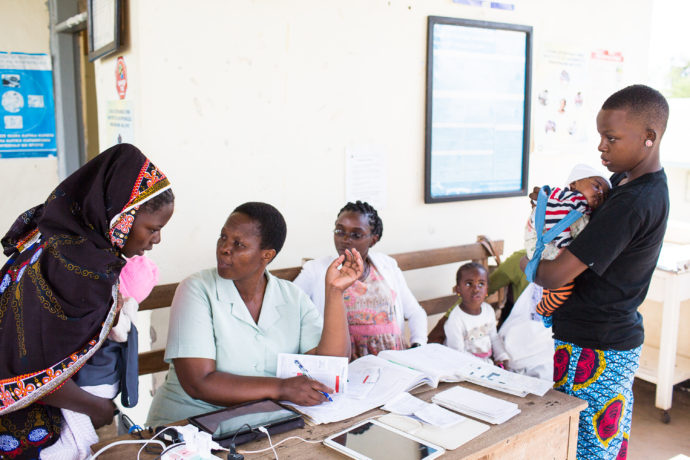New publication defines building blocks for a successful electronic immunization registry
By By Celina Kareiva, Senior Communications Associate, BID Initiative
Aug 13, 2019
Posted in People, Policies & Practices, Practices

Photo: PATH/Trevor Snapp. Health workers consult patients during an immunization session at the Usa River Health Center in Tanzania.
The BID Initiative has just released an exciting new publication that will benefit other countries interested in implementing their own electronic immunization registries (EIRs). In the new journal article, “Electronic immunization registries in Tanzania and Zambia: Shaping a minimum viable product for scaled solutions,” which appeared in the multi-disciplinary, open-access journal, Frontiers in Public Health, BID hopes to help other countries avoid the costly, time-consuming, and complex ramp-up often required of these digital platforms.
EIRs have been shown to improve the quality, availability, and accessibility of routine immunization data so that health workers can make more informed actions based on the information at their fingertips. EIRs help health workers track children who have missed vaccines, identify coverage rates, and improve the timeliness of immunization. BID worked with governments of Tanzania and Zambia to design, develop, introduce, and scale an EIR in both countries. In the process, BID also defined a comprehensive set of system requirements to ensure that both countries’ EIRs meet the needs of the health workers using them.
System requirements are the building blocks that define the different capabilities of the system, allowing it to run smoothly and efficiently. Over the course of five years, BID invested in four different systems before eventually arriving at two solutions now in use in Tanzania and Zambia. As a result of this software development process, BID achieved a platform that provides cutting edge technology and serves as a minimum viable product (MVP) needed to ensure a usable EIR. Through the development process a set of requirements were identified for the successful initial deployment of an EIR, which fit into five thematic areas of functionality, including vaccine administration, client management, stock management, reports, and registration and search requirements.
The learnings and best practices identified throughout the process promise to benefit other countries interested in introducing an EIR or other health service registry. To learn more, read the full article in Frontiers in Public Health.
